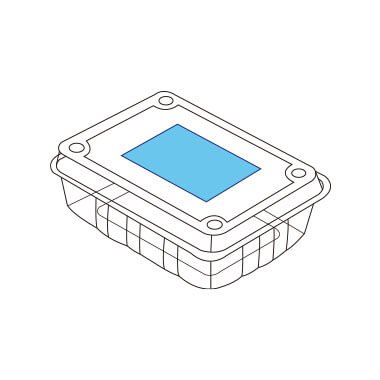In the fast-paced world of modern manufacturing and e-commerce, where efficiency and accuracy are paramount, automated tabletop labeling systems have emerged as a game-changer for businesses handling boxes, trays, and other flat-surface packaging. Whether you’re a small-scale producer or a growing enterprise, investing in the right labeling system can not only save you valuable time but also significantly reduce errors and improve your bottom line.
With advancements in technology, automated tabletop labeling systems are now more accessible and versatile than ever before, enabling companies of all sizes to streamline their labeling processes. In this comprehensive guide, we’ll dive deep into everything you need to know about these systems, including their features, benefits, applications, how to choose the right system, and expert tips on maximizing their value for your business.
Why Are Automated Labeling Systems Essential for Boxes and Trays?
The Problems with Manual Labeling
Despite the availability of automated solutions, many businesses still rely on manual labeling for packaging. While this might work for small-scale operations or low volumes, manual labeling presents several inherent challenges, especially as production scales up. Some of the most common issues with manual labeling include:
- Misaligned Labels: One of the most frustrating issues with manual labeling is misalignment. Inaccurate placement of labels not only affects the aesthetics of the product but can also lead to incorrect information being displayed, resulting in customer dissatisfaction.
- Inconsistent Placement: Manual labeling is prone to inconsistency, with some labels being placed too high, too low, or at an incorrect angle. This inconsistency can be especially problematic in industries where branding and labeling uniformity are critical.
- Wasted Materials Due to Rework: When labels are applied incorrectly or off-center, workers must discard the flawed packaging and redo the labeling, leading to material waste and increased production costs.
- Slower Production Speeds: Manual labeling is often slower than automated alternatives. This can lead to bottlenecks in production, making it harder to meet customer demands or increasing operational downtime.
These challenges highlight the need for automation. Automated tabletop labeling systems address these pain points effectively by offering higher precision, speed, and versatility, ultimately improving overall production efficiency and reducing errors.
The Solution: Automation
Automated tabletop labeling systems are designed to overcome the inefficiencies of manual labeling by offering several advantages:
- Precision: Laser-guided systems ensure that labels are applied accurately every time, minimizing errors and inconsistencies.
- Speed: Depending on the model, automated systems can label up to 100 boxes or trays per minute, drastically improving production speed and throughput.
- Versatility: These systems are capable of handling various packaging shapes, sizes, and materials, making them suitable for a wide range of industries.
- Cost Savings: By reducing the reliance on manual labor and minimizing waste, automated labeling systems can lead to significant cost savings over time.
Example: Consider a mid-sized e-commerce company that was struggling with labeling errors and slow production speeds. After switching to an automated tabletop labeling system, the company reduced its labeling errors by 90% and increased its daily output by 40%, allowing them to meet rising customer demand with ease.
Key Features to Look for in an Automated Tabletop Labeling System
When choosing a tabletop labeling system, it’s crucial to understand the key features that will directly impact your business’s efficiency and productivity. Below are the most important features to look for:
1. Precision Label Placement
- Laser-Guided Positioning: High-quality labeling systems come equipped with laser-guided positioning technology, which ensures that the labels are applied exactly where they are needed, even on irregular or non-flat surfaces. This is particularly beneficial when working with trays, which may have curves or uneven surfaces.
- Adjustable Label Heads: A good system will have adjustable label heads that can accommodate different label sizes and placements. Whether you need to apply labels to the top, side, or bottom of a box or tray, an adjustable head ensures flexibility in positioning.
2. High-Speed Performance
- Throughput Rates: Look for systems with high throughput rates that can label at least 50-100 units per minute, depending on your production needs. Higher throughput rates allow businesses to handle larger volumes and reduce the need for additional staff.
- Quick Changeover: The ability to quickly switch between different box or tray sizes is crucial in maintaining a smooth operation. Many modern systems offer tool-free adjustments, allowing for easy and fast reconfiguration of the labeling system, minimizing downtime between product runs.
3. Versatility
- Multi-Surface Compatibility: Automated tabletop labeling systems should be able to handle a wide range of surfaces, from cardboard boxes and plastic trays to even metal containers. This versatility allows businesses to label different types of packaging with a single system, improving efficiency.
- Label Type Support: Make sure the system is compatible with a variety of label types. These could include paper labels, synthetic labels, and thermal transfer labels, giving you flexibility in label materials depending on your product and packaging requirements.
4. User-Friendly Interface
- Touchscreen Controls: A user-friendly interface is essential for minimizing errors and improving ease of use. Look for systems that feature touchscreen controls with intuitive menus, making it simple to program label positions and other settings.
- Pre-Set Templates: Some systems come with pre-set templates that allow you to save configurations for different packaging types. This feature can be particularly useful if you handle multiple products or packaging variations, as it saves time on reprogramming.
5. Durability and Maintenance
- Stainless Steel Construction: High-quality systems are made from stainless steel, which resists wear and tear in high-volume environments. This ensures the longevity of your system, even in demanding conditions.
- Self-Cleaning Mechanisms: Many automated tabletop labelers are equipped with self-cleaning mechanisms to reduce the frequency of manual maintenance. This feature helps reduce downtime and ensures the system remains operational for longer periods.
Applications of Automated Tabletop Labeling Systems
Automated tabletop labeling systems are used in a variety of industries that require efficient, accurate, and fast labeling solutions for their products. Here are a few key applications:
1. E-Commerce and Logistics
- Use Case: E-commerce companies and logistics providers need to label shipping boxes with barcodes, tracking numbers, and branding information. Given the high volume of shipments, labeling must be fast and precise to meet delivery deadlines.
- Benefit: By automating the labeling process, e-commerce companies can significantly streamline their fulfillment operations, reducing labeling errors and improving delivery accuracy. This not only improves operational efficiency but also enhances customer satisfaction.
2. Food and Beverage
- Use Case: The food and beverage industry often uses automated labeling systems for labeling trays containing fresh produce, baked goods, or meal kits. These products must be labeled with important information such as ingredients, nutritional facts, and expiration dates.
- Benefit: Automated labeling ensures that products are consistently labeled with the correct information, helping businesses comply with food safety regulations such as those set by the FDA or the EU. It also improves packaging speed and reduces manual labor costs.
3. Pharmaceuticals
- Use Case: Pharmaceuticals and healthcare companies use automated tabletop labeling systems to apply labels to medication boxes, including batch numbers, expiration dates, and other regulatory information.
- Benefit: Pharmaceutical packaging must meet strict compliance standards, including the UDI (Unique Device Identifier) and GMP (Good Manufacturing Practices). Automated labeling systems ensure that these standards are consistently met while reducing the risk of human error.
4. Retail and Consumer Goods
- Use Case: Automated tabletop labeling systems are also commonly used in the retail and consumer goods sectors, where branded labeling for product boxes or gift trays is essential for enhancing shelf appeal.
- Benefit: These systems help companies maintain a uniform look across all product packaging, improving brand recognition and providing a more professional appearance. The ability to apply labels quickly and consistently helps companies stay competitive in the retail market.
Top 3 Automated Tabletop Labeling Systems for 2024
Choosing the right automated tabletop labeling system depends on your specific business needs, including labeling speed, packaging size, and budget. Here’s a comparison of the best systems for 2024:
| Feature | Tabletop Top Labeling Machine | Tabletop Top & Bottom Labeling Machine | Tabletop Corner Labeling Machine |
|---|---|---|---|
| Max Speed | 40-80 units/min | 40-80 units/min | 30-60 units/min |
| Label Placement | Top | Top, Bottom | Side, Corner |
| Box Size Range | Length 40-300 mm Width 40-200 mm Height 0.2-130 mm | Length 40-300 mm Width 40-200 mm Height 0.2-130 mm | Length 40-300 mm Width 40-200 mm Height 0.2-130 mm |
| Touchscreen | ✅ | ✅ | ✅ |
How to Choose the Right System for Your Business
Step 1: Assess Your Needs
Before purchasing an automated tabletop labeling system, it’s crucial to assess your unique requirements. Understanding your labeling needs will help you choose the best system for your business. Here are the key factors to consider:
- Volume: The first question to ask is how many boxes or trays you label daily. If you’re labeling hundreds or thousands of units a day, you need a system with a higher throughput rate, typically around 80-100 units per minute. On the other hand, for lower volumes, an entry-level system with a lower speed range may suffice.
- Packaging Types: What types of packaging are you working with? Do you handle multiple sizes, materials, or shapes? Automated tabletop labeling systems vary in terms of size compatibility, so it’s essential to choose a system that can handle your packaging, whether it’s small trays, large boxes, or even irregularly shaped items.
- Budget: As with any capital investment, your budget plays a crucial role in your decision. Labeling systems range from affordable entry-level models to high-end, premium machines with advanced features. Identify your price range and balance it with the desired functionality to get the best value for your investment.
Step 2: Test Before You Buy
Once you have a shortlist of potential systems, it’s important to test before making a final decision. Request a demo or trial to see the system in action, especially to ensure it’s a good fit for your packaging and production line. Testing gives you the chance to evaluate:
- Compatibility: Provide samples of your packaging to ensure that the system can handle your specific materials, sizes, and shapes without issues.
- Ease of Use: Check if the system’s user interface is intuitive, and whether your staff can operate the system effectively with minimal training.
- Performance: Evaluate how well the system performs in real-world conditions. Is the labeling speed sufficient for your needs? Are labels applied accurately and consistently?
Step 3: Consider Future Growth
Your business needs today may not be the same as your needs tomorrow. Choosing a system that can scale with your business is important for long-term success. Look for systems with modular designs that allow for future upgrades, such as adding additional label heads or expanding the system to accommodate higher volumes.
Also, think about the possibility of expanding into different packaging types or materials in the future. The more versatile your labeling system is, the better it will support the growth of your business without requiring a complete system overhaul down the road.
ROI of Automated Labeling Systems
Investing in an automated labeling system is not only a wise decision for operational efficiency, but it also provides tangible returns on investment (ROI). Here are some key areas where businesses see significant savings and improvements:
1. Labor Savings
One of the most immediate benefits of automation is a reduction in labor costs. By switching from manual labeling to an automated system, companies can reduce the need for manual labor and minimize the risk of errors caused by human factors.
- For example, a business that once required five employees to manually label products might only need one or two employees to monitor the automated system, drastically reducing the cost of labor over time.
2. Material Savings
Automated systems improve the accuracy and consistency of label placement, which in turn reduces material waste. This is particularly important for businesses working with expensive labels, such as thermal transfer or custom-printed labels. Automated systems ensure that each label is applied precisely, minimizing the need to discard incorrectly labeled packaging.
3. Increased Output
Automated labeling systems can significantly increase output without requiring additional staff. With labeling speeds reaching up to 100 units per minute or more, these systems allow businesses to meet higher production demands without the need for overtime or additional workforce.
For example, consider a business that labels 500 units per day. With automation, this could easily be increased to 2,000 or more units per day, enabling businesses to scale up production without sacrificing quality.
Maintenance Tips for Long-Term Performance
To ensure that your automated tabletop labeling system continues to operate smoothly and efficiently, it’s essential to follow a regular maintenance routine. Proper care can extend the lifespan of your system and prevent unexpected downtime. Here are some tips to keep your system in top condition:
Daily Maintenance
- Clean Label Heads and Sensors: Dust, label residue, or adhesive buildup can interfere with the accuracy of the labeling system. Cleaning the label heads and sensors daily will ensure that the system continues to function optimally.
Weekly Maintenance
- Inspect Belts and Rollers: Check the belts and rollers for signs of wear and tear. These components are vital for moving products through the labeling process, so they must be in good condition to maintain proper operation.
Monthly Maintenance
- Lubricate Moving Parts: Lubricating moving components such as gears and motors helps ensure smooth movement and reduces the risk of mechanical failures.
- Update Software: Many modern labeling systems feature software that can be updated for improved functionality. Always ensure that your system is running the latest software updates to avoid any security or performance issues.
Pro Tip: Schedule Annual Servicing
To avoid costly breakdowns and unplanned downtime, consider scheduling annual servicing with the manufacturer or an authorized service provider. A professional service technician can perform comprehensive checks and ensure your system is operating at peak efficiency.
FAQs About Automated Tabletop Labeling Systems
1. Can These Systems Handle Irregularly Shaped Trays?
Yes, many modern automated tabletop labeling systems come with adjustable arms and sensors that can accommodate irregularly shaped trays. These features allow the system to adapt to different product shapes, ensuring accurate label placement even on non-flat surfaces.
2. Are They Compatible with Thermal Transfer Labels?
Most systems are fully compatible with thermal transfer, direct thermal, and pre-printed labels. This provides flexibility, as thermal transfer labels are known for their durability, making them ideal for products that need to withstand handling or exposure to harsh conditions.
3. How Long Does It Take to Set Up?
Setup time varies depending on the complexity of the system, but for most models, basic setup typically takes between 1-2 hours. However, additional time may be required for programming label positions and fine-tuning settings for your specific packaging.
4. What’s the Lifespan of a Labeling System?
With proper maintenance, automated tabletop labeling systems can last 10+ years. Regular upkeep and servicing are essential to ensuring that the system continues to perform at its best over its lifespan.
Ready to Upgrade Your Labeling Process?
As businesses continue to face increasing demands for speed, efficiency, and accuracy, automated tabletop labeling systems are no longer a luxury but a necessity. Whether you’re labeling shipping boxes for e-commerce, trays for food packaging, or medication boxes for the pharmaceutical industry, the right labeling system can transform your operations.
In 2024, investing in automation will give your business a competitive edge, improve product quality, and reduce operational costs. If you haven’t already upgraded your labeling process, now is the time to consider making the change.
